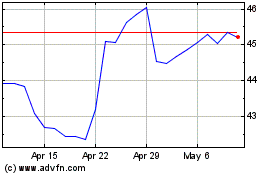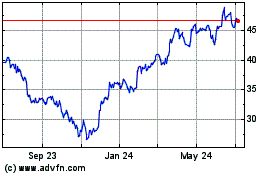Ford Posts Record Results as Truck Revamp Pays Off-Update
April 28 2016 - 9:07AM
Dow Jones News
By Christina Rogers
Ford Motor Co. reaped the benefits of its costly F-150 truck
revamp, doubling net income in the first quarter and posting a
North American operating margin rivaling those returned by high-end
luxury brands.
The Dearborn, Mich., company is among a field of auto makers
benefiting from record U.S. light-vehicle demand and low gasoline
prices, a trend fueling sales of the most profitable units on
dealer lots. As sales of trucks and SUVs soar, Ford is enjoying a
disproportionate advantage over its Detroit rivals due to product
redesigns rolled out since Chief Executive Mark Fields took over in
mid-2014.
Ford is also gaining steam in China, making nearly a
half-billion dollars in a market where it traditionally has been
far behind General Motors Co. and other global heavyweights. That
momentum, combined with an abrupt reversal of fortunes in Europe,
is more than offsetting weakness in South America, Russia and other
emerging markets.
Ford reported net income of $2.5 billion, or 61 cents a share,
up from $1.2 billion, or 29 cents a share, in the first quarter of
2015. Whereas the first three months of last year were dogged by
short supply of a new F-150 as the best-selling vehicle in the U.S.
was being converted to an aluminum body, the company was able to
flood the market with that truck in 2016.
In North America, Ford posted a 12% margin in the first quarter,
far outpacing the 8.7% delivered by GM during the same quarter and
7.2% reported by Fiat Chrysler Automobiles NV.
The margin follows a quarter when Ford relied heavily on fleet
sales to support market-share growth in the U.S. Typically
considered to be less profitable than retail sales, fleet reliance
had been a source of concern for analysts.
On an operating basis, the company earned $3.8 billion or 68
cents per share, and the margin in its global automotive business
nearly hit 10%. While far less than the global margin for some
Japanese auto makers who traditionally benefited from currency
translation, Ford's result is considered strong by Detroit's
standards.
The results handily beat analyst expectations of 48 cents a
share and could cheer investors who have been concerned that Ford's
profitability has peaked as growth in the U.S. appears to be
cooling. Ford shares were up nearly 2% in premarket trading, but
Wednesday's $13.66 closing price represented a 3% decline compared
with the beginning of the year.
Ford's revenue increased 11% to $37.7 billion, up from $33.9
billion in the same period a year ago.
"You're starting to see a better balance of profitability,"
Chief Financial Officer Bob Shanks said while talking to reporters,
citing improving results in Asia and Europe. He said the company
also still has opportunity for profit growth in the U.S.
As far as the belief that the best days are behind conventional
auto makers after a half-decade of strong earnings, Mr. Shanks
said, "we're proving that to be a misconception," he said. There is
no sign that U.S. light-vehicle demand is headed for a pothole, he
said. He disputed suggestions that the U.S. economy could be headed
for a mild recession.
The company's launch of a new Super Duty F-Series truck is
coming in the third-quarter. A heavier-duty version of its pickup
truck line, Mr. Shanks said, it is the first major overhaul in 19
years and it should help lift earnings in the back half of the
year.
Robust demand for Ford's pricier trucks, including the F-150
pickup, in the U.S. continued to drive its operating profits in
North America, which nearly doubled to $3.1 billion in the first
quarter versus a year ago. Ford's U.S. sales grew 8.4% in the first
quarter.
Ford posted its best quarter in Europe since 2008, swinging to a
$434 million pre-tax profit from a $42 million loss in the same
period in 2015.
Profit in Asia Pacific doubled to $220 million versus $105
million a year ago amid growing profitability in China. Ford's
equity income from its Chinese joint ventures was up 23% to $443
million in the just-ended quarter.
The loss in South America -- which is suffering from wider
economic malaise -- widened to $256 million.
Write to Christina Rogers at christina.rogers@wsj.com
(END) Dow Jones Newswires
April 28, 2016 08:52 ET (12:52 GMT)
Copyright (c) 2016 Dow Jones & Company, Inc.
General Motors (NYSE:GM)
Historical Stock Chart
From Mar 2024 to Apr 2024

General Motors (NYSE:GM)
Historical Stock Chart
From Apr 2023 to Apr 2024
